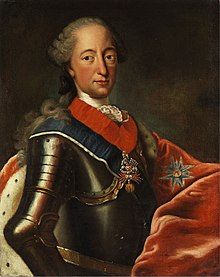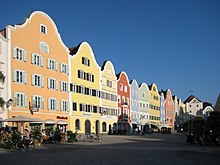Innviertel
Coordinates: 48 ° 15 ' N , 13 ° 20' E
| Quarter and districts of Upper Austria |
|---|
The Innviertel , (officially: Innkreis ), is the north-western quarter of Upper Austria and includes the districts Braunau am Inn , Ried im Innkreis and Schärding . Since the formation of the political districts in 1868, the quarters in Upper Austria no longer have a legal basis and are purely landscape names. The older district division , which was still based on the old quarters, was replaced.
Unlike the rest of Upper Austria, most of the area was part of Bavaria until 1779 (cession in the Peace of Teschen ) . It is a fertile, densely populated, flat to hilly landscape of the Alpine foothills and lies between the Salzach , Inn , Danube and Hausruck . The area of the Innviertel is around 2250 km² and the population is just under 218,000.
The largest city in the Innviertel in terms of area and inhabitants is Braunau am Inn with 17,518 inhabitants, followed by Ried im Innkreis (12,220). No less well-known and a tourist center due to the baroque city center is the city of Schärding with 5269 inhabitants (population on January 1st, 2020).
Surname

The name Innviertel for this region is comparatively young. Before that, the name Innbaiern was in use. Innviertel did not come into use until it was incorporated into Austria in 1779, because at that time the Archduchy ob der Enns (today's Upper Austria ) was divided into four quarters. According to this administrative structure, the newly acquired area was initially referred to as the Fifth Quarter , and after the merging of Mühlviertel and Machlandviertel, it was finally called Innviertel .
history

Bavaria: Middle Ages and Modern Times
Today's Innviertel with the ducal courts of Ranshofen and Mattighofen has belonged to Mattiggau in the Bavarian tribal duchy since the 6th century , the northern part to Rottachgau . From 1507 Innbaiern was part of the Burghausen Rent Office with the Wildshut courts (merged with the Mattighofen district court), Braunau , Mauerkirchen , Friedburg , Schärding and Ried . The Mondseeland in the south of Bavaria was lost to the Habsburgs in 1506.
During the Bavarian people's uprising in 1705/06, Braunau was the seat of the Bavarian State Defense Congress (December 1705), the so-called " Braunau Parliament ". It called for a revolt against the imperial Habsburg oppression.
Habsburg era: Peace of Teschen and Congress of Vienna
The area was only separated from the Electorate of Bavaria after the War of the Bavarian Succession . This war was triggered by the death of the childless Bavarian Elector Maximilian III. Joseph (1745 to 1777). With his death, the Bavarian line of the Wittelsbach family died out. A number of Central European powers laid claim to parts of the inheritance, including and above all Austria with demands for the cession of Lower Bavaria and the Upper Palatinate . With the ratification of the Peace of Teschen , which ended the War of the Bavarian Succession, the Innviertel became part of Upper Austria in 1779.
Due to the Peace of Schönbrunn in 1809, Bavaria took possession of the Innviertel again in 1810. It was assigned to the Bavarian Lower Danube District together with parts of the Hausruckviertel . In 1811 the parishes in this area were also separated from the Diocese of Linz and assigned to the Diocese of Passau . It was not until the Treaty of Munich that the Kingdom of Bavaria finally ceded the Innviertel and other areas to the Austrian Empire on May 1, 1816 . On July 1, 1816, the diocese of Linz also took over the corresponding areas from the diocese of Passau.

Language and Bavarian Heritage
At the political level, a series of measures (oath of allegiance by the royal Bavarian officials, homage by the Innviertel nobility to the new sovereign) brought about the integration of the new part of the country into the land above the Enns . More difficult was the administrative integration, which was carried out by a separate "state facility commission" under the direction of Baron Franz Xaver Pockensteiner von Wolffenbach , since the Innviertel was not an administrative unit until then, but had been administered from Burghausen, which had remained Bavarian. When the reforms of Emperor Josef II were strengthened by the introduction of new church and school rules, in 1795 there were secret gatherings of the population in the parish of St. Georgen. The higher drinks taxes, which forced breweries to close, also aroused public resentment. So the residents of Innbaiern did not have much fun with their return and for a long time the saying was in circulation: "Better to die Bavarian than imperial ruin!"
Linguistically, despite the extensive adoption of the Austrian standard vocabulary, dialect peculiarities of West Central Bavarian were retained in the Innviertel; which mainly consist of a large number of typical regional vocalization features (e.g. the word milk, referred to as Milli or Muich in the Innviertel, is mostly known as Müch in the rest of Austria), has been preserved to this day (compare Bavarian language ). In the west they continuously change into the West-Central Bavarian dialects.
In the architecture of the cities, the colorfully painted house facades of the Inn-Salzach style are still reminiscent of the Bavarian tradition.
National exhibitions
The first Bavarian-Upper Austrian regional exhibition took place in 2004 in Passau , Asbach , Reichersberg and Schärding. This is the third time that Reichersberg has hosted an Upper Austrian provincial exhibition. From April 27 to November 4, 2012, the second joint state exhibition of the State of Upper Austria and the Free State of Bavaria took place. The venues were the monastery Ranshofen near Braunau am Inn, the Mattighofen Castle and the Burghausen Castle in Bavaria.
Antagonism to the rest of Upper Austria
The Innviertel was still a center of the violent Bavarian uprising against the Austrian occupation in 1705 and 1706. After the change of country in 1779, however, no broader resistance formed. For example, Franz Stelzhamer , who dealt with reciprocal citizenship in his prosaic work “Dá Soldatnvödá”, became an Upper Austrian “national poet” in the 19th century.
Nonetheless, up until the 20th century there were disputes between groups from Innviertel and so-called “Landlers” (“Landl” is used as a name for the Hausruckviertel or Upper Austria in general) at the colliery level . Well-known sayings and declarations of war, such as "Wenn d 'Innviertler keman, hoasts umirucka!" In recent years, a certain local rivalry has tended to shift further east to the state capital Linz , even after institutional rapprochement, for example in the tourism sector, from the Grieskirchen district to the Innviertel, and is primarily expressed in sporting competitions and political and public debates about discrimination of the Innviertel compared to the central regions of Upper Austria, which at times dominate the reporting in the local media.
One of these political points of contention for years has been the inadequately developed road connection to the nearby city of Salzburg , on which the upper Innviertel (Braunau district, south-western parts of the Ried district) as a central region is oriented. Nevertheless, the connection Vienna-Linz-Munich is an important transport route. As the urban center of the lower Innviertel (Schärding district, northeastern parts of the Ried district), Passau plays a major role. A perceived independence of the Innviertel is also reflected in the "capital city debate", which was kicked off by the Mayor of Ried, Albert Ortig, during the 2009 election campaign and in which he declared the middle center of Ried to be the capital of the Innviertel and thus above all provoked the politics of Braunau .
Despite all the circumstances mentioned, the Innviertel as a region today is by far the largest identity-creating reference point for its residents compared to the remaining quarters of Upper Austria, which partly, with the exception of the Mühlviertel, which is bordered by the Danube, deviate spatially from today's district boundaries.
NUTS breakdown: AT311
In the official statistics of the EU led NUTS headings from being Innviertel something defined otherwise. It is one of the five groups of districts ( NUTS level : AT -3) in Upper Austria, carries the code AT311and comprises the following 4 political districts : Braunau am Inn , Ried im Innkreis , Schärding , Grieskirchen . Including the Grieskirchen district, which is traditionally part of the Hausruckviertel, the AT311 Innviertel region has around 282,000 inhabitants on an area of around 2825 km²
In statistics at the European level, Upper Austria is therefore not divided into its traditional four quarters, but into its regions Innviertel, Mühlviertel , Traunviertel , Linz-Wels and Steyr-Kirchdorf. This also corresponds to the modern spatial planning concept in which the Upper Austrian central area is singled out as the "fifth" quarter.
The Landtag constituency of Innviertel with the seat of the electoral authority in Ried im Innkreis consists of the 3 traditional Innviertel districts of Ried im Innkreis, Braunau am Inn and Schärding.
gallery
Maria Schmolln (view from the hunting chapel)
Oberinnviertler Seenplatte, Holzöstersee
See also
literature
- Ludwig Maier (Hrsg.): G'wunna has recently only unsoans! The Bavarian people's uprising 1705/1706 in the War of the Spanish Succession. From the Innviertel to Tölz, to the Sendlinger Murder Christmas and to the Battle of Aidenbach . Munich 2005, ISBN 3-902121-68-8 .
- Herbert Wurster: Heimat am Inn , culture and history, Simbach / Braunau / Inn 1999 (see also www.hrb.at).
- Günther Kleinhanns, Anton Hauser: The Innviertel . Jugend und Volk, Vienna 1991, ISBN 3-224-17656-3 .
- Siegfried Haider : History of Upper Austria . R. Oldenbourg, Munich 1987, ISBN 3-486-54081-5 .
- Roger M. Allmannsberger, Gerhard Schwentner: The district court Ried (= Historical Atlas of Bavaria . Part I / 2: Innviertel ). Bavarian Academy of Sciences, Munich 2017, ISBN 978-3-7696-6561-1 .
- Gerhard Schwentner: The district court Schärding . Ed .: Commission for Bavarian State History (= Historical Atlas of Bavaria . Part I / 1: Innviertel ). Bavarian Academy of Sciences, Munich 2014, ISBN 978-3-7696-6559-8 .
Web links
- Innviertel.at
- Tourism Innviertel website
- Overview map of the quarter borders (PDF file; 341 kB) on DORIS
- Classification of NUTS III regions in Upper Austria
- Photos from the Innviertel on "Flickr"
- Culture, customs and traditions of the inhabitants of the Innkreis, 1832
Individual evidence
- ↑ Haider, 1987, pp. 222f.
- ↑ Watered down borders in the Innviertel. In: weekly view . May 7, 2016, accessed February 8, 2020 .
- ^ Project Gutenberg: Dá Soldatnvödá , accessed on January 23, 2012.
- ↑ Dieter Seitl: Ortig in Braunau: "Ried is and remains the capital of the Innviertel!" In: Oberösterreichische Nachrichten . November 25, 2010, accessed February 8, 2020 .
- ↑ For background information on Eurostat's NUTS classification, see Background. NUTS - Nomenclature of territorial units for statistics. Eurostat , accessed February 8, 2020 . NUTS classification in direct download (Excel file, 527 kB).









